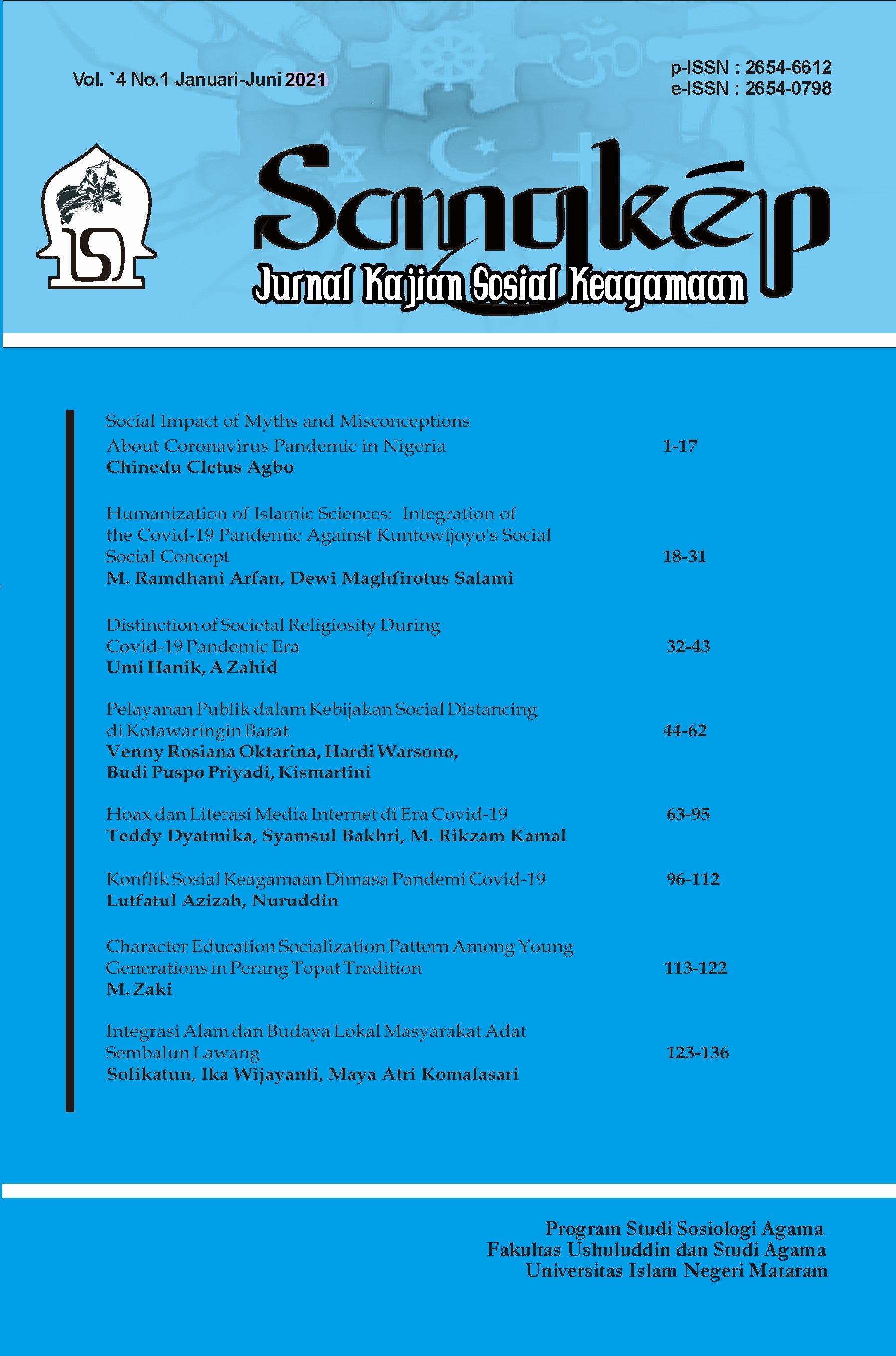Social Impact of Myths and Misconceptions About Coronavirus Pandemic in Nigeria
Main Article Content
Abstract
This study is about the social impact of myths and misconceptions about coronavirus pandemic in Nigeria. The study has the following objectives: to highlight the myths and misconceptions about the coronavirus; examine major propagators of these myths and misconceptions, highlight the consequent social impact, examine the relationship between the myths and misconceptions and the fight against the coronavirus pandemic. The study employed the descriptive and explanatory design method. Questionnaires in addition to library research were applied for data collection. Primary data sources were used and data analysed using the chi square and correlation statistical tool at 5% level of significance which was presented in frequency tables and percentages. The respondents under the study were 100 online respondents from all the geopolitical zones of the country. Results of the study revealed huge social impact of the myths and misconceptions about the coronavirus pandemic which has also affected its effective fight. It concludes that efforts should be made by the Nigeria Centre for Disease Control (NCDC) and related stakeholders in promoting awareness of this virus for reducing/eradicating the myths and misconceptions around it and effectively fighting the COVID-19 pandemic.
Downloads
Article Details
References
Abati, R. (April 7, 2020). Corona Blues. Available online at http://saharareporters.com/2020/04/07/corona-blues-reuben-abati
Brug, J., Aro, A. R. &Richardus, J. H. (2009). Risk perceptions and behaviour: Towards pandemic control of emerging infectious diseases: International research on risk perception in the control of emerging infectious diseases. International Journal of Behavioural Medicine, 16(1), 3-6. doi: 10.1007/s12529-008-9000-x.
Brug, J., Aro, A.R., Oenema, A., de Zwart, O., Richardus, J. H., & Bishop, G. D., (2004). SARS risk perception, knowledge, precautions, and information sources, the Netherlands. Emerg. Infect. Dis. 10, 1486–1489
Choi, J. S. & Yang, N. Y. (2010). Perceived knowledge, attitude, and compliance with preventive behavior on influenza A (H1N1) by university students. J. Korean Acad. Adult Nurs. 22 (3), 250–259.
Ewodage, R. (March 22, 2020). COVID-19: How We Plan To Implement Social Distancing In Lagos Markets, Transport System – Sanwo-Olu. Available online at https://www.channelstv.com/2020/03/22/covid-19-how-we-plan-to-implement-socialdistancing-in-lagos-markets-transport-system-sanwo-olu/
Hassan, I. (March 26, 2020). The other COVID-19 pandemic: Fake news. Available online at https://africanarguments.org/2020/03/26/the-other-covid-19-pandemic-fake-news/
Hussain, Z. A., Hussain, S. A., &Hussain, F. A., (2012). Medical students' knowledge, perceptions, and behavioral intentions towards the H1N1 influenza, swine flu, in Pakistan: a brief report. Am. J. Infect. Control 40 (3), e11–e13. doi:10.1016/j.ajic.2011.12.004
Lau, J. T. F., Yang, X., Tsui, H., & Kim, J. H. (2003). Monitoring community responses to the SARS epidemic in Hong Kong: from day 10 to day 62. J EpidemiolCommun Health, 57:864–70
Leppin, A. &Aro, A.R. (2009). Risk perception related to SARS and avian influenza: theoretical foundations of current behavioral research. International Journal of Behavioral Medicine, 16(1),7–29. doi:10.1007/s12529-008-9002-8.
Sauer, L. M. (2020). What Is Coronavirus? Available online at https://www.hopkinsmedicine.org/health/conditions-and-diseases/coronavirus
Vartti, A. M., Oenema, A., Schreck, M., Uutela, A., de Zwart, O., Brug, J., &Aro, A. R. (2009). SARS knowledge, perceptions, and behaviors: A comparison between Finns and the Dutch during the SARS outbreak in 2003. International Journal of Behavioral Medicine, 16 (1), 41–48
Voeten, H., de Zwart, O., Veldhuijzen, I. K., Yuen, C., Jiang, X., Elam, G., Abraham T. &Brug, J. (2009). Sources of Information and Health Beliefs Related to SARS and Avian Influenza among Chinese Communities in the United Kingdom and The Netherlands, Compared to the General Population in these Countries. International Journal of Behavioral Medicine, 16 (1), 49–57.doi: 10.1007/s12529-008-9006-4 World Health Organization.
(WHO, 11 March, 2020). WHO Director-General’s opening remarks at the media briefing on COVID-19—11 March 2020. Geneva, Switzerland: World Health Organization; 2020. Available online at https://www.who.int/dg/speeches/detail/who-director-general-s-opening-remarks-at-themedia-briefing-on-covid-19—11-march-2020
Worldometers (April 9, 2020). Coronavirus Update (Live). Available online at https://www.worldometers.info/coronavirus/
WHO(April 12, 2020).Health topics: Coronavirus. https://www.who.int/healthtopics/coronavirus#tab=tab_1, accessed: 10-04-2020.
WHO (March 30, 2020). Director-General's opening remarks at the media briefing on COVID-19. World Health Organization, March 3, 2020, https://www.who.int/dg/speeches/detail/who-director-general-s-openingremarks-at-the-media-briefing-on-covid-19---3-march-2020, accessed: 06-04-2020.
OWD (April 27, 2020). Coronavirus: the-growth-rate-of-covid-19-deaths. Available online at https://ourworldindata.org/, accessed: 27-04- 2020.
NCDC (April 27, 2020). https://covid19.ncdc.gov.ng, accessed: 27-04-2020.
ACDC (April 27, 2020). https://africacdc.org/covid-19, accessed: 27-04-2020.
CNBC News (April 8, 2020). https://www.cnbc.com/2020/04/07/whatsapp-limits-message-forwards-to-combatcoronavirus-misinformation.html, accessed: 08-04-2020.
Colson, P., Rolain, J. M. and Raoult, D., (2020). Chloroquine for the 2019 Novel Coronavirus SARS-CoV-2, International Journal of Antimicrobial Agents, 55(3): 1-2,doi: https://doi.org/10.1016/j.ijantimicag.2020.105923.
OIE (April 6, 2020). https://www.oie.int/en/scientific-expertise/specific-information-andrecommendations/questions-and-answers-on-2019novel-coronavirus, accessed: 06-04-2020.
USDA (April 6, 2020). https://www.aphis.usda.gov/aphis/newsroom/news/sa_by_date/sa-2020/ny-zoo-covid-19, accessed: 06-04-2020.
CDC (April 6, 2020). https://www.cdc.gov/coronavirus/2019-ncov/daily-life-coping/animals.html, accessed: 06-04-2020.
Martinez-Alvarez Et Al (2020). COVID-19 Pandemic in West Africa. The Lancet Global Health, 1-2, doi: https://doi.org/10.1016/S2214-109X(20)30123-6.
Huppert, A. and Katriel, G., (2013). Mathematical modelling and prediction in infectious disease epidemiology. Clinical microbiology and infection, 19(11): 999-1005.

